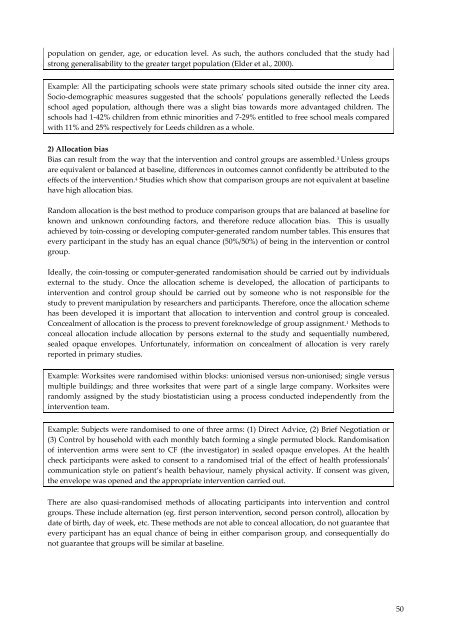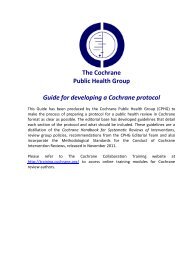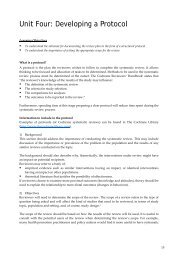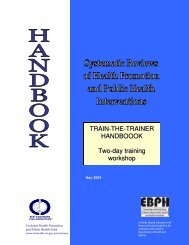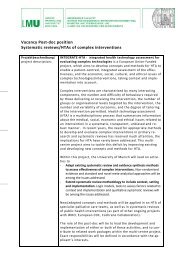Unit Eight: Principles of Critical Appraisal - Cochrane Public Health ...
Unit Eight: Principles of Critical Appraisal - Cochrane Public Health ...
Unit Eight: Principles of Critical Appraisal - Cochrane Public Health ...
Create successful ePaper yourself
Turn your PDF publications into a flip-book with our unique Google optimized e-Paper software.
population on gender, age, or education level. As such, the authors concluded that the study had<br />
strong generalisability to the greater target population (Elder et al., 2000).<br />
Example: All the participating schools were state primary schools sited outside the inner city area.<br />
Socio‐demographic measures suggested that the schools’ populations generally reflected the Leeds<br />
school aged population, although there was a slight bias towards more advantaged children. The<br />
schools had 1‐42% children from ethnic minorities and 7‐29% entitled to free school meals compared<br />
with 11% and 25% respectively for Leeds children as a whole.<br />
2) Allocation bias<br />
Bias can result from the way that the intervention and control groups are assembled. 3 Unless groups<br />
are equivalent or balanced at baseline, differences in outcomes cannot confidently be attributed to the<br />
effects <strong>of</strong> the intervention. 4 Studies which show that comparison groups are not equivalent at baseline<br />
have high allocation bias.<br />
Random allocation is the best method to produce comparison groups that are balanced at baseline for<br />
known and unknown confounding factors, and therefore reduce allocation bias. This is usually<br />
achieved by toin‐cossing or developing computer‐generated random number tables. This ensures that<br />
every participant in the study has an equal chance (50%/50%) <strong>of</strong> being in the intervention or control<br />
group.<br />
Ideally, the coin‐tossing or computer‐generated randomisation should be carried out by individuals<br />
external to the study. Once the allocation scheme is developed, the allocation <strong>of</strong> participants to<br />
intervention and control group should be carried out by someone who is not responsible for the<br />
study to prevent manipulation by researchers and participants. Therefore, once the allocation scheme<br />
has been developed it is important that allocation to intervention and control group is concealed.<br />
Concealment <strong>of</strong> allocation is the process to prevent foreknowledge <strong>of</strong> group assignment. 1 Methods to<br />
conceal allocation include allocation by persons external to the study and sequentially numbered,<br />
sealed opaque envelopes. Unfortunately, information on concealment <strong>of</strong> allocation is very rarely<br />
reported in primary studies.<br />
Example: Worksites were randomised within blocks: unionised versus non‐unionised; single versus<br />
multiple buildings; and three worksites that were part <strong>of</strong> a single large company. Worksites were<br />
randomly assigned by the study biostatistician using a process conducted independently from the<br />
intervention team.<br />
Example: Subjects were randomised to one <strong>of</strong> three arms: (1) Direct Advice, (2) Brief Negotiation or<br />
(3) Control by household with each monthly batch forming a single permuted block. Randomisation<br />
<strong>of</strong> intervention arms were sent to CF (the investigator) in sealed opaque envelopes. At the health<br />
check participants were asked to consent to a randomised trial <strong>of</strong> the effect <strong>of</strong> health pr<strong>of</strong>essionals’<br />
communication style on patient’s health behaviour, namely physical activity. If consent was given,<br />
the envelope was opened and the appropriate intervention carried out.<br />
There are also quasi‐randomised methods <strong>of</strong> allocating participants into intervention and control<br />
groups. These include alternation (eg. first person intervention, second person control), allocation by<br />
date <strong>of</strong> birth, day <strong>of</strong> week, etc. These methods are not able to conceal allocation, do not guarantee that<br />
every participant has an equal chance <strong>of</strong> being in either comparison group, and consequentially do<br />
not guarantee that groups will be similar at baseline.<br />
50


